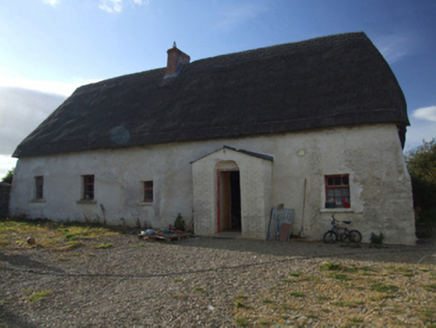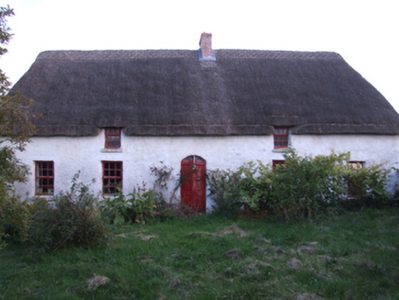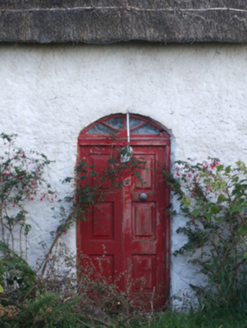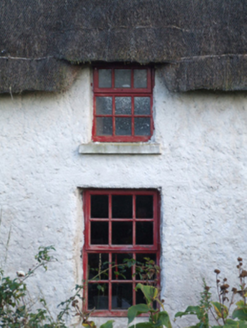Survey Data
Reg No
15701722
Rating
Regional
Categories of Special Interest
Architectural, Historical, Social
Original Use
Farm house
Date
1700 - 1748
Coordinates
320015, 147576
Date Recorded
14/09/2007
Date Updated
--/--/--
Description
Detached three- or five-bay single-storey lobby entry thatched farmhouse with dormer attic, extant 1748, on a rectangular plan; five-bay full-height rear (south) elevation. Occupied, 1901; 1911. Refenestrated, ----. "Restored", 2002. Now disused. Chicken wire-covered replacement hipped wheat thatch roof with exposed hazel lattice stretchers to ridge having exposed scallops, repointed red brick Running bond off-central chimney stack having corbelled stepped capping supporting terracotta pots, and exposed hazel stretchers to eaves having exposed scallops. Limewashed lime rendered battered walls. Segmental-headed central door opening with overgrown threshold, and concealed dressings framing timber panelled double doors having fanlight. Square-headed window openings with concrete or rendered sills, and concealed dressings framing replacement timber casement windows replacing six-over-six (ground floor) or three-over-six (dormer attic) timber sash windows having part exposed sash boxes. Set in unkempt grounds perpendicular to road with piers to perimeter having pyramidal capping supporting wrought iron-detailed flat iron gate.
Appraisal
A farmhouse identified as an important component of the vernacular heritage of County Wexford by such attributes as the alignment perpendicular to the road; the rectilinear lobby entry plan form centred on a restrained doorcase showing a simple radial fanlight; the construction in unrefined local materials displaying a pronounced battered silhouette with sections of "daub" or mud suggested by an entry in the "House and Building Return" Form of the National Census (NA 1901; NA 1911); the somewhat disproportionate bias of solid to void in the massing; and the high pitched roof showing a wheat thatch finish replenished with the financial assistance of a grant (2002) from The Heritage Council: meanwhile, such traits as the symmetrical frontage clearly illustrate aspirations to "gentrified" architecture (cf. 15703323; 15703330; 15704863; 15705322). Having been well maintained, the elementary form and massing survive intact together with quantities of the original fabric, both to the exterior and to the interior: the recent introduction of replacement fittings to most of the openings, however, has not had a beneficial impact on the character or integrity of the composition. Furthermore, adjacent "tin roofed" outbuildings (extant 1839) continue to contribute positively to the group and setting values of a neat self-contained ensemble having historic connections with the Redmond family including Michael Redmond (d. 1810); Reverend Pierce Redmond (d. 1831); and Pierce Redmond (d. 1908), 'Farmer late of Gerry Clonevan [sic] County Wexford' (Calendars of Wills and Administrations 1909, 504).







